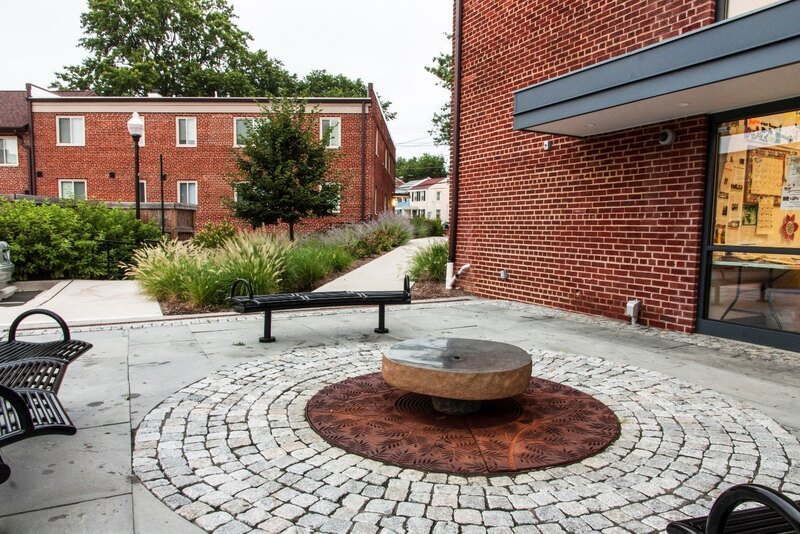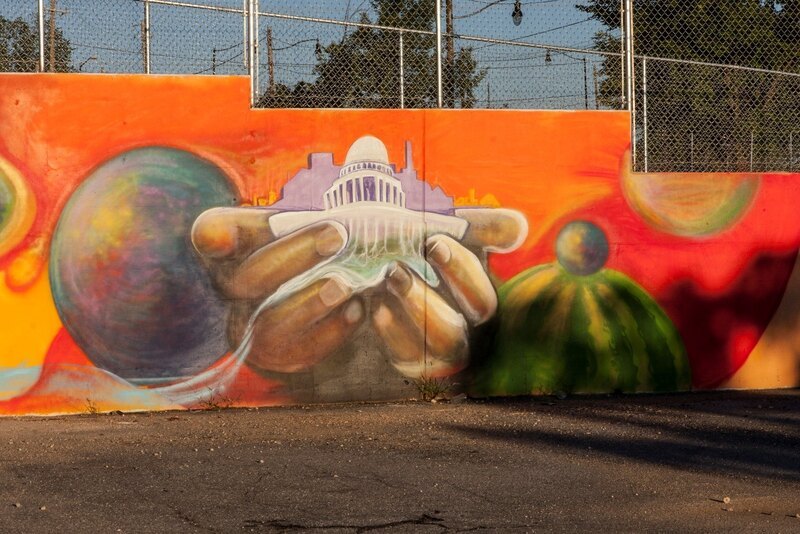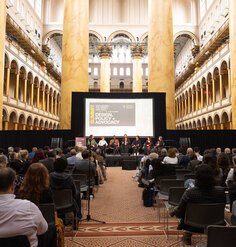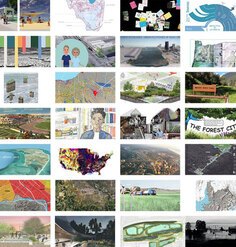Equity and Inclusion in Practice: Bradley Site Design

In issuing the New Landscape Declaration, the Landscape Architecture Foundation made a commitment to strengthen and diversify our global capacity as a profession and to cultivate a bold culture of inclusive leadership, activism, and advocacy within our ranks. To promote these values, LAF is showcasing ways in which design firms are demonstrating leadership on issues of diversity, equity, and inclusion (DEI). Below, we highlight how Bradley Site Design is developing a framework for more thoughtful and lasting design in underserved communities.
Take a walk through Bass Circle, a residential community in southeast Washington DC, and you’ll notice hallmarks of “good” landscape architecture. Lush plantings surround walkways and entryways. Pristine edging clearly marks boundaries between materials and space. Benches and a fountain area with subtle details invite residents to relax outdoors. By any measure, it is a beautiful site that would merit praise in design circles. But these features pale in comparison to the less obvious benefits woven into this community.
Present on the grounds are abundant native plantings, a community garden, an indoor-outdoor community space for after school programs and job training programs, and 67 bioretention facilities that utilize existing topography to slow, filter, and reduce stormwater flows—exceeding requirements and allowing the property to claim Stormwater Retention Credits, which offset maintenance costs. It’s the first community in the District to employ Low Impact Development measures at this scale. Getting to these solutions was no easy feat for Project Manager Sharon Bradley. It involved thorough collaboration with leaders in the community, lots of time and patience, and what Sharon playfully describes as “stealing all the civil engineers’ money from the budget.”
For Bradley Site Design, Bass Circle also offered early lessons and served as a jumping-off point for a much larger initiative, Design For Impact (D41). Sharon and her team of eight are developing a framework that not only takes into consideration the unique safety, health, and wellness needs of a project’s surrounding community but also measures the social, environmental, and economic benefits of a more tailored approach to design. For over a decade, Bradley Site Design has been building its portfolio of projects where the D41 framework was used, each time adding to the available resources, tools, and strategies aimed at addressing a variety of challenges. Sharon hopes to synthesize her team’s experience to guide designers at other firms through a structured set of questions that drive designers toward more sustainable and inclusive designs.

Sharon spent her early career at Oehme van Sweden & Associates (OvS). Working at a large firm specializing in high-end projects offered Sharon the freedom to exercise her creativity without constraint. Through a connection at OvS, Sharon found an opportunity to co-manage a project for an affordable housing complex, which marked a pivot in her career. “I was captivated by that project… It seemed so much more rewarding, for me. It was transformative.”
This experience presented Sharon with a new objective: to bring the level of excellence of an OvS design to places that do not traditionally garner that same attention and investment. Sharon asserts, “It’s possible to achieve quality design and healthy outcomes in any community, on any budget.” At the newly-established Bradley Site Design, Sharon began working toward that vision, bringing landscape architecture backed by rigorous methods and standards to projects in underserved neighborhoods.
Bass Circle provided Sharon with two major insights: it testified to the feasibility and benefits of her approach, but also demonstrated the need to “make the case” to developers, clients, and partners. Sharon’s team managed to incorporate the 67 planted bioretention areas by diverting funds away from the sub-service infrastructure budget and leaning on the promise of reduced maintenance costs over time. The process of negotiating and re-molding project plans made it clear that a formalized program would better position designers to advocate for these solutions with confidence.
D4I grew from this realization. The analysis process allows for a deeper understanding of the project community, from which relevant goals and associated design responses can be determined. Attaching quantifiable value to those elements empowers design teams and stakeholders to defend them using empirical terms. By identifying social, environmental, and economic factors that baseline project requirements may overlook and grounding practical knowledge in quantifiable, metric-driven indicators, D4I holds tremendous potential to reorient typical landscape architecture practice. Sharon stresses the importance of streamlining this decision-making process so that practitioners can easily incorporate the framework into their existing design process.
The D4I framework establishes and protects elements of equity. For example, when Bradley Site Design teamed with District and federal agencies, organizations, community groups, and other design firms to design and build a community park, the result had far-reaching impacts that went well beyond the beautification of the site. Built on a vacant 3-acre parcel in a food desert in Ward 7, the East Capitol Urban Farm features urban agriculture and smaller-scale community gardens, a farmer’s market area, a Nature Discovery Area, Aquaponics facilities with entrepreneurship programs, a workshop and performance area, a walking loop, and a vibrant mural by local Ward 7 artist Jay Coleman. The project was installed in a massive community-build day effort involving over a thousand local residents, school groups, and professional and faith-based organizations.

When considering the barriers to impactful design, Sharon acknowledges that practitioners inevitably come up against the clock in their client-based work. The race against time is an inevitable product of capitalism. And while Sharon remains hopeful about alternative economic models, citing Kate Raworth’s “Doughnut Economics” as an area of research interest, she aims to create a paradigm shift within landscape architecture’s existing profit-structure. “The end goal is to change the way we’re practicing as a profession in a way that’s realistic. We’re businesses and we have to operate as businesses.”
Bradley Site Design Sustainability Leader Yoshi Kubota has played an integral role in advancing D4I as a robust package, developing templates that outline common challenges underserved neighborhoods face, as well as the pros and cons of available design solutions. Though, the knowledge of those who will ultimately interact with the site cannot be succinctly distilled into or overridden by a prescriptive set of recommendations. Sharon recalls one particularly vivacious community member who possessed an understanding and effortless command of local residents, and loaned her talents to a project in Louisville, KY. “She is the expert in that community, not us. She’s going to tell us a lot of what we need to know about the people--what they want, what they fear, what they love.”
35 years of experience have shown Sharon that active residents such as these are the true key to a project’s longevity. They carry on the programs, contribute to placemaking, and rally others to do the same long after planners and designers are gone. “A photogenic community garden or playground can look good and make magazine covers, but if people don’t feel safe inhabiting that space day and night, it’s not a sustainable space.” That’s why D4I also includes intangible solutions, such as building relationships, connecting partners, and empowering residents, in its flow chart.
D4I is no small endeavor, and Bradley Site Design still has a way to go before it can deliver a resource that firms can streamline into their day-to-day business. For Sharon, the Black Lives Matter movement and widespread spotlight on racial inequality have reinforced the urgency of disseminating the toolkit so that it can be used by others to foster more equitable design in the public realm. Her team has committed to implementing D4I on every one of their projects moving forward to ensure that their work enhances space on the terms of its inhabitants, not those of design discourse and aesthetics. Anticipating that some firms may see these extra measures as a disruption to their design process, Sharon proudly quips, “We’re a small firm without a lot of resources. If we can do it, most of the rest of the practitioner world can do it.”










